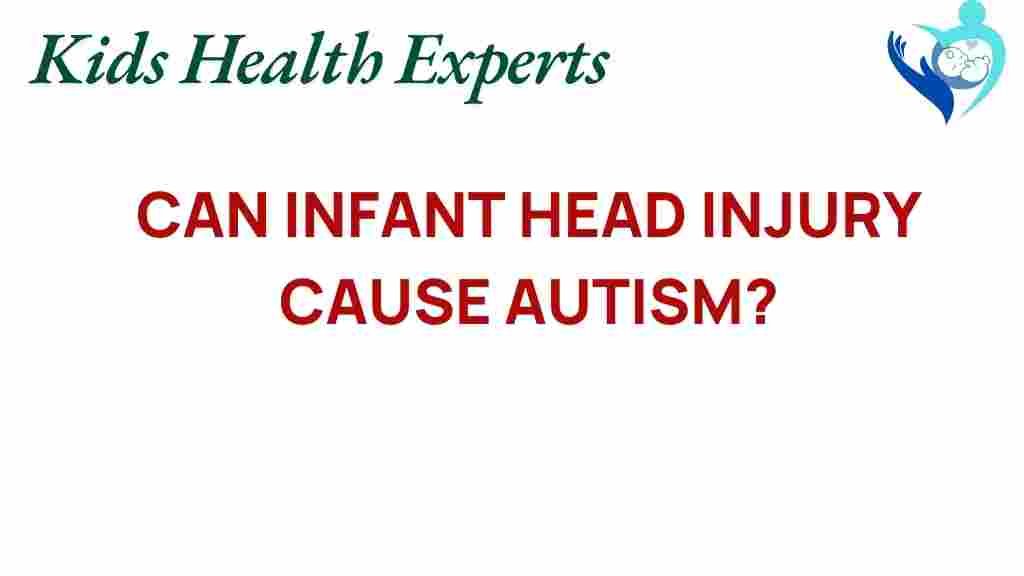Unraveling the Connection: Can Infant Head Injury Lead to Autism?
The relationship between infant head injury and autism spectrum disorder (ASD) has garnered significant attention in recent years. As parents become increasingly aware of the developmental risks associated with early childhood injuries, understanding the neurological impact of head trauma is crucial. This article will delve into the potential connections between infant head injuries and ASD, explore research findings, and address common parental concerns.
Understanding Infant Head Injury
Infant head injuries can occur due to various reasons, including falls, accidents, and abuse. It is essential to recognize the types of head injuries that can affect an infant:
- Minor Injuries: These include bumps and bruises that generally heal without complications.
- Moderate Injuries: These may involve concussions and require medical evaluation.
- Severe Injuries: These can lead to significant brain injuries, necessitating immediate medical intervention.
Each of these injuries carries different developmental risks that can impact a child’s growth and behavior.
Autism Spectrum Disorder: An Overview
Autism spectrum disorder is a complex neurodevelopmental condition characterized by challenges in social communication, repetitive behaviors, and restricted interests. The symptoms can vary widely, making it essential to identify early signs for timely intervention.
The Neurological Impact of Head Injuries
Research suggests that head injuries during early childhood can have profound effects on brain development. The infant brain is highly plastic, meaning it can adapt and reorganize itself; however, this plasticity can also make it vulnerable to injuries.
Studies indicate that:
- Head injuries can disrupt normal brain development, affecting cognitive and emotional functions.
- Children who experience traumatic brain injuries (TBIs) may face an increased risk of developing behavioral and psychological issues, including symptoms characteristic of ASD.
Research Findings Linking Head Injury and Autism
Several studies have attempted to draw a connection between infant head injury and the development of autism spectrum disorder. Key findings include:
- A study published in the journal Pediatrics highlighted that children with a history of moderate to severe head injuries exhibited higher rates of ASD symptoms.
- Research from the Journal of Neurotrauma indicated that infants who sustained head trauma were at a greater risk for developmental delays, including social communication difficulties.
- A meta-analysis found that the timing and severity of the injury are crucial factors in determining long-term outcomes, including the potential for ASD.
Step-by-Step Process: Identifying Risks and Symptoms
Parents should be vigilant in monitoring their child’s development, especially after experiencing a head injury. Here’s a step-by-step process for identifying potential risks associated with infant head injury:
Step 1: Observe Behavior Post-Injury
After an infant experiences a head injury, closely monitor their behavior:
- Look for changes in social interactions.
- Watch for increased irritability or emotional outbursts.
- Track any regression in developmental milestones.
Step 2: Consult Pediatric Health Professionals
If you notice any concerning changes, consult your child’s pediatrician. They can conduct evaluations and recommend specialists if necessary. Early intervention is critical in addressing potential issues.
Step 3: Educate Yourself on ASD Symptoms
Familiarize yourself with the signs of autism spectrum disorder:
- Difficulty with eye contact.
- Challenges in understanding social cues.
- Repetitive behaviors or routines.
Step 4: Seek Early Intervention Services
If your child exhibits symptoms of ASD, early intervention services can provide support and improve outcomes. These may include:
- Speech therapy
- Occupational therapy
- Behavioral therapy
Common Parental Concerns
Many parents worry about the long-term effects of head injuries on their child’s development. Here are some frequently asked questions:
1. What should I do if my infant has a head injury?
Immediately seek medical attention, even for minor injuries, to rule out any serious conditions.
2. Can a head injury cause autism?
While research indicates a correlation between head injuries and an increased risk of ASD symptoms, it is essential to note that not all children who experience head injuries will develop autism.
3. How can I support my child if they show signs of ASD?
Engage in early intervention programs, and consider therapies that focus on social skills and communication.
4. Are there preventive measures for head injuries?
Yes, ensuring a safe environment, using appropriate safety gear, and supervising your child can help minimize the risks of head injuries.
Troubleshooting Tips for Parents
Supporting a child with a history of head injuries or developmental challenges can be overwhelming. Here are some troubleshooting tips:
- Stay Informed: Regularly update yourself on the latest research regarding infant head injury and autism spectrum disorder.
- Communicate with Healthcare Providers: Maintain open lines of communication with your child’s pediatrician and any specialists involved in their care.
- Join Support Groups: Connecting with other parents facing similar challenges can provide emotional support and practical advice.
- Focus on Strengths: Emphasize your child’s strengths and interests, fostering a positive environment for growth.
Conclusion: The Importance of Awareness and Early Intervention
Understanding the potential connection between infant head injury and autism spectrum disorder is vital for early detection and intervention. While research continues to explore the complexities of this relationship, parents must remain proactive in monitoring their child’s development.
By staying informed, seeking professional guidance, and fostering a supportive environment, parents can help mitigate the risks associated with head injuries and promote healthy development in their children. Remember, early intervention is key to navigating potential challenges, and being proactive can lead to better outcomes for children affected by both brain injury and ASD.
For more information on pediatric health and developmental milestones, visit this resource.
This article is in the category Conditions and created by KidsHealthExperts Team
